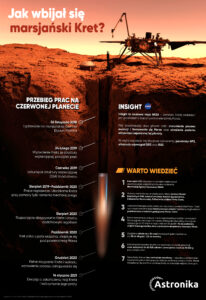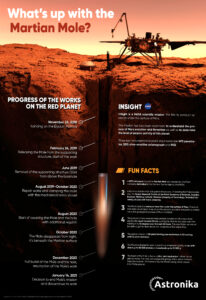In January 2021, more than two years after landing on Mars, NASA decided to finalise the job of the HP3 Instrument, the so-called Mole. Its activity resulted with valuable lessons learned and information about the geology of Mars and proved that the Red Planet can still be surprising. Today, after analysing new information from the principal investigators: NASA and DLR, we summarise this stage of the mission.
The HP3 Penetrator, equipped with a hammering mechanism developed by Astronika, operated on the surface of Mars as one of the three key instruments of the InSight mission. Its original task was to bury itself five meters below the surface of the planet and measure the temperature along the way. Despite repeated attempts by the NASA team of engineers, the research could not be carried out at depth higher than 40 cm due to unpredictable parameters of the martian soil.
Reasoning
Łukasz Wiśniewski, member of the Astronika board, explains:
“After starting work on Mars, it turned out that the outer layer of regolith (duricrust), which the Mole had to penetrate through, is not only thicker than expected, but also has a very cohesive structure. What is more, during the first days of the Mole’s work, regolith – impacted by several thousand blows – had increased its density. This resulted in the following: the hole penetrated by the device had a much larger diameter than the device itself, and thus there was no friction necessary to continue the burial. It should be emphasized, however, that the Mole itself functioned properly at all times, performed several thousand strokes and many temperature measurements. Without any damage, it endured unforeseen emergency works, such as pressing its backcap with a robotic arm’s scoop – we have achieved full success in this field. Aside from important data about the Martian regolith close to the surface, we know how to prevent such situations in the future, for example by improving systems of moles’ insertion at the work site. It should also be remembered that the Mole is the first device of its type to penetrate a planetary soil on its own, and still remains a useful sensor for scientific data, including temperature.”
The development process of the device started in 2013. The Space Research Centre of the Polish Academy of Sciences also contributed to works on the HP3 Instrument – as part of the original engineering team originated there.
Specialists from the Space Research Centre of the Polish Academy of Sciences said in an official statement that: “The Martian Penetrator has passed all tests carried out by NASA successfully, survived huge overloads during take-off and landing, and endured a six-month journey to Mars. The Space Research Centre of the Polish Academy of Sciences treats the two-year period of operation of the device on Mars as a valuable area of study. Even on Earth, research work encounters insurmountable problems, and here we are talking about conducting experiments on other, still very poorly understood planets. Any activity related to space exploration always carries enormous risks. The number of elements that could fail is enormous. However, each subsequent attempt brings us closer to the goal of getting to know our cosmic surroundings better.”
Experience
Activities of the InSight mission have been extended by NASA until 2022. During this time, the other two instruments will be collecting data on Mars, focusing on seismic activity and the Doppler shift between the Red Planet and Earth. However, it will be done with much less intensity than before due to dust accumulation on solar panels, which has reduced energy production on the lander.
“The experience gained while working with the Mole will also be used immediately. Thus, the cable connecting the SEIS Instrument with the lander will be covered in a layer of regolith, which, according to the scientists, will eliminate potential interference. The experience given to scientists and engineers by the Mole is huge. It contributed, among other things, to inventing new methods of operation and increased precision of the robotic arm movements, which will be used by subsequent units controlling similar devices. Moreover, the mere fact that we encountered a different type of regolith at the landing site than at the previously visited areas is a wonderful discovery. How the Mole worked with martian regolith and what formations it encountered on its way – all this will give scientists a new perspective on martian geology and the processes of interaction with regolith in planetary conditions”
– summarizes Gordon Wasilewski, research and development engineer at Astronika.




